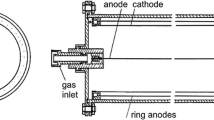Abstract
Assessment of radioactive contamination of construction materials used in deep underground experiments has been carried out using ultra-sensitive analytical methods such as radiometrics, inductively coupled plasma mass spectrometry (ICPMS), accelerator mass spectrometry (AMS), and neutron activation analysis. The lowest detection limits, < 1 nBq g−1, has been obtained with ICPMS and AMS techniques.



Similar content being viewed by others
References
Arnold R et al (2010) Probing new physics models of neutrinoless double beta decay with SuperNEMO. Eur Phys J C 70:927–943
Agostini M et al (2016) Search of neutrinoless double beta decay with the GERDA experiment. Nucl Part Phys Proc 273–275:1876–1882
Abgrall N et al (2015) The Majorana Demonstrator neutrinoless double-beta decay experiment-Majorana Collaboration. Adv High Energy Phys 2014:365432
Abgrall N et al (2017) The large enriched germanium experiment for neutrinoless double beta decay. AIP Conf Proc 1894:020027
Alimonti G et al (2009) The Borexino detector at the Laboratori Nazionali del Gran Sasso. Nucl Instrum Methods Phys Res A 600:568–593
Angloher G et al (2017) CRESST collaboration. Eur Phys J C 77:637–645
Angloher G et al (2014) EURECA conceptual design report. Phys Dark Univ 3:41–74
Arnold R et al (2015) Results of the search for neutrinoless double beta-decay in 100Mo with the NEMO-3 experiment. Phys Rev D 92:072011
Povinec PP (2017) Background constraints of the SuperNEMO experiment for neutrinoless double beta-decay searches. Nucl Instrum Methods Phys Res A 845:398–403
Povinec PP et al (2008) New isotope technologies in environmental physics. Acta Phys Slov 58:1–154
Povinec PP (2012) New gamma-spectrometry technologies for environmental sciences. J Anal Sci Technol 3:42–71
Povinec PP (2018) New ultra-sensitive radioanalytical technologies for new science. J Radioanal Nucl Chem. https://doi.org/10.1007/s10967-018-5787-3
Laubenstein M et al (2004) Underground measurements of radioactivity. Appl Radiat Isotopes 61:167–172
Loaiza P et al (2015) Obelix, a new low-background HPGe at Modane Underground Laboratory. AIP Conf Proc 1672(1):130002-1
Brudanin VB et al (2017) The low-background HPGe gamma-spectrometer OBELIX for the investigation of the double beta decay to excited states. IOSR-JAP 9:22–29
Laubenstein M (2017) Screening of materials with high purity germanium detectors at the Laboratori Nazionali del Gran Sasso. Int J Mod Phys A 32:1743002
Breier R, Laubenstein M, Povinec PP (2017) Monte Carlo simulation of background characteristics of a HPGe detector operating underground in the Gran Sasso National Laboratory. Appl Radiat Isotopes 126:188–190
Breier R, Brudanin VB, Loaiza P, Piquemal F, Povinec PP, Rukhadze E, RukhadzeV Štekl I (2018) Environmental radionuclides as contaminants of HPGe gamma-ray spectrometers: Monte Carlo simulations for Modane underground laboratory. J Environ Radioact 190–191:134–140
Povinec PP (2018) Analysis of radionuclides at ultra-low levels: a comparison of low and high-energy mass spectrometry with gamma-spectrometry for radiopurity measurements. Appl Radiat Isotopes 126:26–30
Budjáš D et al (2009) Gamma-ray spectrometry of ultra-low levels of radioactivity within the material screening program for the GERDA experiment. Appl Radiat Isotopes 67:755–758
Abgrall N et al (2016) The Majorana demonstrator radioassay program. Nucl Instrum Methods Phys Res A 828:22–36
Palušová V, Breier R, Piquemal F, Povinec PP (2018) Monte Carlo simulation of environmental background sources of a HPGe detector operating in Modane underground laboratory. J Radioanal Nucl Chem (in print)
Loaiza P et al (2017) The BiPo-3 detector. Appl Radiat Isotopes 123:54–59
Barabash A et al (2017) The BiPo-3 detector for the measurement of ultra-low natural radioactivities of thin materials. JINST 12:P06002
Agyriades J et al (2010) Results of the BiPo-1 prototype for radiopurity measurements for the SuperNEMO double beta decay source foils. Nucl Instrum Methods Phys Res A 622:120–128
Roos P (2008) Analysis of radionuclides using ICPMS. In: Povinec PP (ed) Analysis of environmental radionuclides. Elsevier, Amsterdam, pp 295–330
Nisi S et al (2009) Comparison of inductively coupled mass spectrometry and ultra-low-level gamma-ray spectroscopy for ultra-low background material selection. Appl Radiat Isotopes 67:828–832
LaFerriere BD et al (2015) A novel assay method for the trace determination of Th and U in copper and lead using inductively coupled plasma mass spectrometry. Nucl Instrum Methods Phys A 775:93–98
Jull AJT et al (2008) Accelerator mass spectrometry of long-lived light radionuclides. In: Povinec PP (ed) Analysis of environmental radionuclides. Elsevier, Amsterdam, pp 240–262
Fifield LK (2008) Accelerator mass spectrometry of long-lived heavy radionuclides. In: Povinec PP (ed) Analysis of environmental radionuclides. Elsevier, Amsterdam, pp 263–295
Famulok N et al (2015) Ultrasensitive detection method for primordial nuclides in copper with accelerator mass spectrometry. Nucl Instrum Methods Phys B 361:193–196
Povinec PP et al (2015) A new IBA-AMS laboratory at the Comenius University in Bratislava (Slovakia). Nucl Instr Methods Phys Res B 342:321–326
Povinec PP et al (2015) Development of the Accelerator Mass Spectrometry technology at the Comenius University in Bratislava. Nucl Instr Methods Phys Res B 361:87–94
Povinec PP et al (2015) Joint Bratislava–Prague studies of radiocarbon and uranium in the environment using accelerator mass spectrometry and radiometric methods. J Radioanal Nucl Chem 304:67–73
Benedik L, Byrne AR (1995) Simultaneous determination of trace uranium and thorium by radiochemical neutron activation analysis. J Radioanal Nucl Chem 189:325–331
Byrne AR, Benedik L (1999) Applications of neutron activation analysis in determination of natural and man-made radionuclides, including 231Pa. Czechoslov J Phys 49S1:263–270
Hou X (2008) Activation analysis for the determination of long-lived radionuclides. In: Povinec PP (ed) Analysis of environmental radionuclides. Elsevier, Amsterdam, pp 370–406
Kučera J, Kameník J, Povinec PP (2017) Radiochemical separation of mostly short-lived neutron activation products. J Radioanal Nucl Chem 311:1299–1307
Lee SH et al (2008) Ultra-low-level determination of 236U in IAEA marine reference materials by ICPMS and AMS. Appl Radiat Isotopes 66:823–828
Acknowledgements
This study was carried out in the framework of the EU Research and Development Operational Program funded by the ERDF (Projects 26240120012, 26240120026 and 26240220004), with partial support from the Slovak Research and Development Agency (Project APVV-15-0576), and from the Slovak Scientific Granting Agency (Project VEGA 1/0891/17).
Author information
Authors and Affiliations
Corresponding author
Rights and permissions
About this article
Cite this article
Povinec, P.P., Benedik, L., Breier, R. et al. Ultra-sensitive radioanalytical technologies for underground physics experiments. J Radioanal Nucl Chem 318, 677–684 (2018). https://doi.org/10.1007/s10967-018-6105-9
Received:
Published:
Issue Date:
DOI: https://doi.org/10.1007/s10967-018-6105-9




